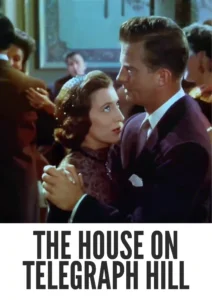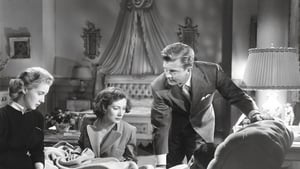Contact: info@alwanfilm.com
Video Sources 0 Views
- Watch trailer
- The House on Telegraph Hill


Synopsis
Table of Contents
ToggleReview: The House on Telegraph Hill 1951 Colorized – A Suspenseful Thriller Set in Post-War America

Introduction
The House on Telegraph Hill, released in 1951, is a gripping suspense thriller directed by Robert Wise. Set against the backdrop of post-war America, the film weaves a tale of intrigue, deception, and betrayal. In this review, we’ll explore the atmospheric world of The House on Telegraph Hill and examine its enduring impact on the thriller genre.
Check The Full Colorized Movies List
Check Our Colorized Movies Trailer Channel
Understanding The House on Telegraph Hill 1951 Colorized: Director, Cast, and Genre
Directed by Robert Wise, The House on Telegraph Hill features a talented cast led by Richard Basehart as Alan Spender and Valentina Cortese as Victoria Kowelska. The film falls within the genre of suspense thriller, known for its tension-filled plot twists and atmospheric storytelling.
Exploring the World of The House on Telegraph Hill 1951 Colorized: Plot and Characters
The House on Telegraph Hill follows the story of Victoria Kowelska, a Polish refugee who assumes the identity of her deceased friend to escape war-torn Europe. Upon arriving in America, Victoria finds herself embroiled in a web of deceit and danger as she uncovers dark secrets hidden within the walls of her new home. As tensions escalate, Victoria must navigate a treacherous landscape of suspicion and intrigue to uncover the truth.
The Art of Film Colorization
While The House on Telegraph Hill was originally filmed in black and white, its early colorized version adds a new layer of visual richness and depth to its atmospheric portrayal of suspense and intrigue. The colorization process enhances the film’s visual appeal and captures the moody atmosphere of its narrative with stunning clarity.
Early Colored Films: A Brief History
The history of early colored films is marked by innovation and experimentation as filmmakers sought to enhance the visual appeal of their movies. From hand-tinted frames to pioneering technicolor processes, the evolution of colorization techniques transformed the cinematic landscape, offering audiences a new way to experience classic stories and atmospheric settings.
The House on Telegraph Hill (1951) and Its Early Colored Version
The decision to release The House on Telegraph Hill in a colorized format was made with the intention of immersing audiences in the atmospheric world of suspense and intrigue. While some purists may prefer the original black and white version, the early colorized edition of the film adds a new dimension to its storytelling and captures the tension-filled atmosphere with stunning visual clarity.
The Debate Over Film Colorization
The debate over film colorization continues to divide audiences and industry professionals alike. While some argue that colorization breathes new life into classic films and makes them more accessible to modern audiences, others maintain that it compromises the artistic integrity of the original work. As technology advances and filmmaking techniques evolve, the debate over colorization remains a topic of ongoing discussion within the film community.
Examining The House on Telegraph Hill (1951) as an Early Colored Film
Viewing The House on Telegraph Hill in its early colorized iteration offers audiences a fresh perspective on its atmospheric portrayal of suspense and intrigue. The colorization process enhances the film’s visual appeal and captures the moody atmosphere of its narrative with stunning clarity. As Victoria Kowelska delves deeper into the mysteries surrounding her new home, viewers are drawn into a world of deception and danger that resonates with timeless relevance.
Influence and Legacy: The House on Telegraph Hill 1951 Colorized’s Impact on Cinema
The House on Telegraph Hill is widely regarded as a classic example of the suspense thriller genre that continues to captivate audiences with its tension-filled plot twists and atmospheric storytelling. Its enduring legacy has inspired generations of filmmakers and influenced the portrayal of suspense and intrigue in cinema. As a testament to its timeless appeal, The House on Telegraph Hill remains a beloved classic that continues to enthrall audiences with its gripping narrative and stylish direction.
Director’s Cinematic Legacy: Beyond The House on Telegraph Hill 1951 Colorized
Robert Wise’s directorial legacy extends far beyond The House on Telegraph Hill, encompassing a diverse body of work that includes dramas, musicals, and science fiction films. As a filmmaker, Wise was known for his versatility, attention to detail, and ability to evoke powerful emotions from his audiences. The House on Telegraph Hill stands as a testament to his talent and creativity, solidifying his reputation as one of the great directors of classic Hollywood cinema.
Themes Explored in The House on Telegraph Hill 1951 Colorized
At its core, The House on Telegraph Hill explores themes of identity, deception, and the consequences of war in the context of post-war America. Through its complex characters and atmospheric storytelling, the film delves into the darker aspects of human nature, exposing the fragility of trust and the allure of deception. As Victoria Kowelska confronts the ghosts of her past, viewers are confronted with profound questions about the nature of truth and the complexities of the human psyche.
Reception and Controversy Surrounding The House on Telegraph Hill 1951 Colorized
Upon its release, The House on Telegraph Hill received widespread critical acclaim for its tension-filled plot twists, atmospheric cinematography, and standout performances. However, the decision to release the film in a colorized format sparked debate among fans and critics alike. While some praised the colorization process for enhancing the film’s visual appeal, others questioned its necessity and expressed concern about preserving the integrity of Wise’s original vision.
Where to Watch The House on Telegraph Hill 1951 Colorized Online
For those eager to experience The House on Telegraph Hill for themselves, the film is readily available on popular streaming platforms such as Amazon Prime Video, Google Play Movies, and iTunes. Whether viewed in its original black and white format or its early colorized iteration, The House on Telegraph Hill offers a gripping and atmospheric cinematic experience that is sure to captivate audiences.
FAQs About The House on Telegraph Hill 1951 Colorized
1. Is The House on Telegraph Hill based on a true story?
No, The House on Telegraph Hill is a fictional suspense thriller that explores themes of identity, deception, and the consequences of war in post-war America. While the characters and storyline are works of fiction, the film’s exploration of human nature and moral ambiguity draws inspiration from real-life experiences and universal themes.
2. Who starred in The House on Telegraph Hill?
The House on Telegraph Hill stars Richard Basehart as Alan Spender and Valentina Cortese as Victoria Kowelska. Their nuanced performances bring depth and complexity to the film’s characters, capturing the psychological tension and moral ambiguity of their relationship.
3. What is the central message of The House on Telegraph Hill?
At its core, The House on Telegraph Hill delivers a powerful message about the consequences of war and the fragility of trust in post-war America. Through its atmospheric storytelling and complex characters, the film explores the darker aspects of human nature and the allure of deception in times of crisis.
4. Why was The House on Telegraph Hill released in a colorized format?
The decision to release The House on Telegraph Hill in a colorized format was made with the intention of immersing audiences in the atmospheric world of suspense and intrigue. While some purists may prefer the original black and white version, the early colorized edition of the film adds a new dimension to its storytelling and captures the tension-filled atmosphere with stunning visual clarity.
5. What is the legacy of The House on Telegraph Hill?
The House on Telegraph Hill is widely regarded as a classic example of the suspense thriller genre that continues to captivate audiences with its tension-filled plot twists and atmospheric storytelling. Its enduring legacy has inspired generations of filmmakers and influenced the portrayal of suspense and intrigue in cinema. As a testament to its timeless appeal, The House on Telegraph Hill remains a beloved classic that continues to enthrall audiences with its gripping narrative and stylish direction.
6. Are there any sequels or remakes of The House on Telegraph Hill?
While there have been no official sequels or remakes of The House on Telegraph Hill, the film’s enduring legacy has inspired countless adaptations and reinterpretations in various media. However, none have achieved the same level of critical acclaim or cultural significance as the original 1951 film.
7. Where can I watch The House on Telegraph Hill online?
For those eager to experience The House on Telegraph Hill for themselves, the film is readily available on popular streaming platforms such as Amazon Prime Video, Google Play Movies, and iTunes. Whether viewed in its original black and white format or its early colorized iteration, The House on Telegraph Hill offers a gripping and atmospheric cinematic experience that is sure to captivate audiences.
Conclusion
In conclusion, The House on Telegraph Hill (1951) stands as a gripping suspense thriller that continues to captivate audiences with its tension-filled plot twists, atmospheric storytelling, and standout performances. Whether viewed in its original black and white format or its early colorized iteration, Robert Wise’s masterful direction and the nuanced performances of the cast offer a cinematic experience that is both timeless and emotionally resonant.
As Victoria Kowelska unravels the mysteries surrounding her new home, viewers are drawn into a world of deception and danger that resonates with timeless relevance. With its enduring legacy and profound exploration of human nature, The House on Telegraph Hill remains a beloved classic that continues to enthrall audiences with its gripping narrative and stylish direction.










